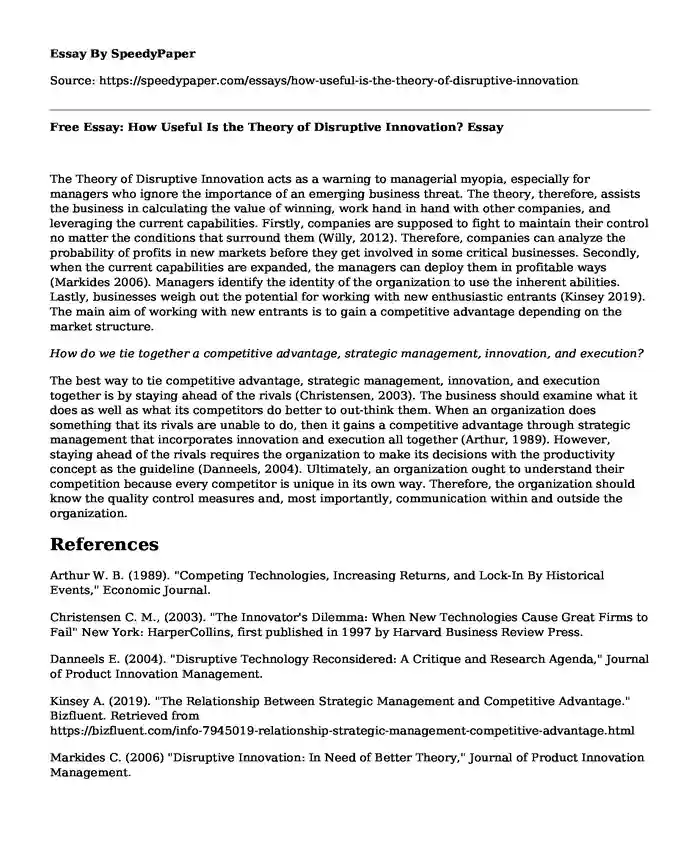
| Type of paper: | Course work |
| Categories: | Organizational behavior Strategic management Leadership management |
| Pages: | 2 |
| Wordcount: | 387 words |
The Theory of Disruptive Innovation acts as a warning to managerial myopia, especially for managers who ignore the importance of an emerging business threat. The theory, therefore, assists the business in calculating the value of winning, work hand in hand with other companies, and leveraging the current capabilities. Firstly, companies are supposed to fight to maintain their control no matter the conditions that surround them (Willy, 2012). Therefore, companies can analyze the probability of profits in new markets before they get involved in some critical businesses. Secondly, when the current capabilities are expanded, the managers can deploy them in profitable ways (Markides 2006). Managers identify the identity of the organization to use the inherent abilities. Lastly, businesses weigh out the potential for working with new enthusiastic entrants (Kinsey 2019). The main aim of working with new entrants is to gain a competitive advantage depending on the market structure.
How do we tie together a competitive advantage, strategic management, innovation, and execution?
The best way to tie competitive advantage, strategic management, innovation, and execution together is by staying ahead of the rivals (Christensen, 2003). The business should examine what it does as well as what its competitors do better to out-think them. When an organization does something that its rivals are unable to do, then it gains a competitive advantage through strategic management that incorporates innovation and execution all together (Arthur, 1989). However, staying ahead of the rivals requires the organization to make its decisions with the productivity concept as the guideline (Danneels, 2004). Ultimately, an organization ought to understand their competition because every competitor is unique in its own way. Therefore, the organization should know the quality control measures and, most importantly, communication within and outside the organization.
References
Arthur W. B. (1989). "Competing Technologies, Increasing Returns, and Lock-In By Historical Events," Economic Journal.
Christensen C. M., (2003). "The Innovator's Dilemma: When New Technologies Cause Great Firms to Fail" New York: HarperCollins, first published in 1997 by Harvard Business Review Press.
Danneels E. (2004). "Disruptive Technology Reconsidered: A Critique and Research Agenda," Journal of Product Innovation Management.
Kinsey A. (2019). "The Relationship Between Strategic Management and Competitive Advantage." Bizfluent. Retrieved from https://bizfluent.com/info-7945019-relationship-strategic-management-competitive-advantage.html
Markides C. (2006) "Disruptive Innovation: In Need of Better Theory," Journal of Product Innovation Management.
Shih W.C. (2012) "Competency-Destroying Technology Transitions: Why the Transition to Digital Is Particularly Challenging," Harvard Business School.
Cite this page
Free Essay: How Useful Is the Theory of Disruptive Innovation?. (2023, May 17). Retrieved from https://speedypaper.com/essays/how-useful-is-the-theory-of-disruptive-innovation
Request Removal
If you are the original author of this essay and no longer wish to have it published on the SpeedyPaper website, please click below to request its removal:
- Free Essay Sample about Installing Hospital Healthcare Monitoring System
- Free Essay Investigating Value Chain Configuration
- Essay Example on Warehouse Management
- Management at Garnier Company - Essay Example
- Paper Example: Nike Brand Analysis
- Paper Example: Project Management as an Accidental Profession
- Velma Company Organizational Behavior and Reward Systems - Free Paper
Popular categories




